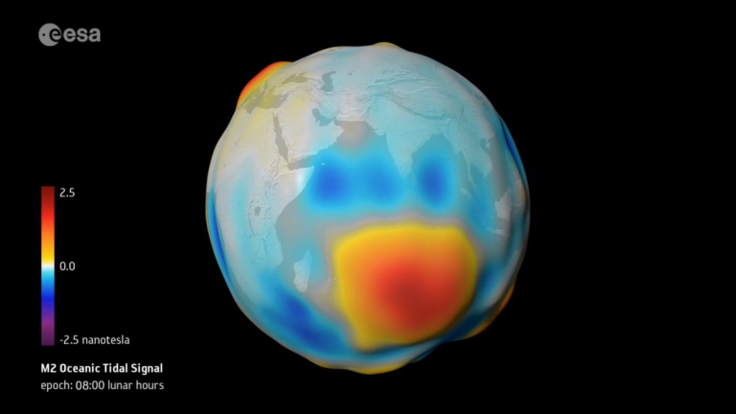Ocean Magnetism: ESA Mapped Earth’s Second Magnetic Field In Unprecedented Detail

Magnetism is one of the most elusive features of our planet, and scientists across the globe are working to understand how it behaves and changes. However, recently, researchers from the European Space Agency (ESA) managed to map another form of magnetic field, one that occurs from the tidal movement of seawater and has never been observed in unprecedented detail.
Typically, Earth’s magnetic field is generated by the hot, swirling liquid iron in its outer core. But, what mostly goes unnoticed is a small portion of this magnetism which includes magnetic field generated by oceans and magnetized rocks in the planet’s crust.
When moon drives ocean tides resulting in the movement of salt water to and from the coast, an electric current is generated resulting in a very weak magnetic signal.
The patterns of this magnetic field are too weak to be measured or tracked, but ESA scientists managed to map them in unprecedented detail, thanks to Swarm — a constellation of three identical satellites operating as part of a mission to study the magnetism of our planet. The agency even released an animation showcasing how the magnetism from ocean changes over a 24-hour period.
"It's a really tiny magnetic field," Physicist Nils Olsen, who presented the observation, told BBC. "It's about 2 – 2.5 nanotesla at satellite altitude, which is about 20,000 times weaker than Earth's global magnetic field."
Swarm satellites have been measuring Earth’s magnetic properties since 2013 from a region 300 kilometers to 530 kilometers above the surface.
“We have used Swarm to measure the magnetic signals of tides from the ocean surface to the seabed, which gives us a truly global picture of how the ocean flows at all depths – and this is new,” Olsen said in an ESA statement.
Understanding how ocean water moves at different levels could also help scientists delve into how heat trapped by the oceans under the effect of greenhouse gases is distributed and stored across the globe. This, as the agency said, could help scientists better understand rapidly accelerating global warming.
Moreover, as tidal magnetism generates a deep response from beneath the seabed, scientists also believe Swarm studies could give them critical insight into the electrical characteristics of our planet’s lithosphere and upper mantle, ultimately helping them know more about the tectonic activity that results in earthquakes and volcanic eruptions. At present, only gravity measurements and seismology are used for this job, but adequate measurements from deep within oceans might get more accurate results, ScienceAlert reported.
The findings were presented at 2018 European Geosciences Union meeting in Vienna, Austria. The annual week-long event hosts scientists from different parts of the world to share discoveries relating to our planet.
© Copyright IBTimes 2024. All rights reserved.




















